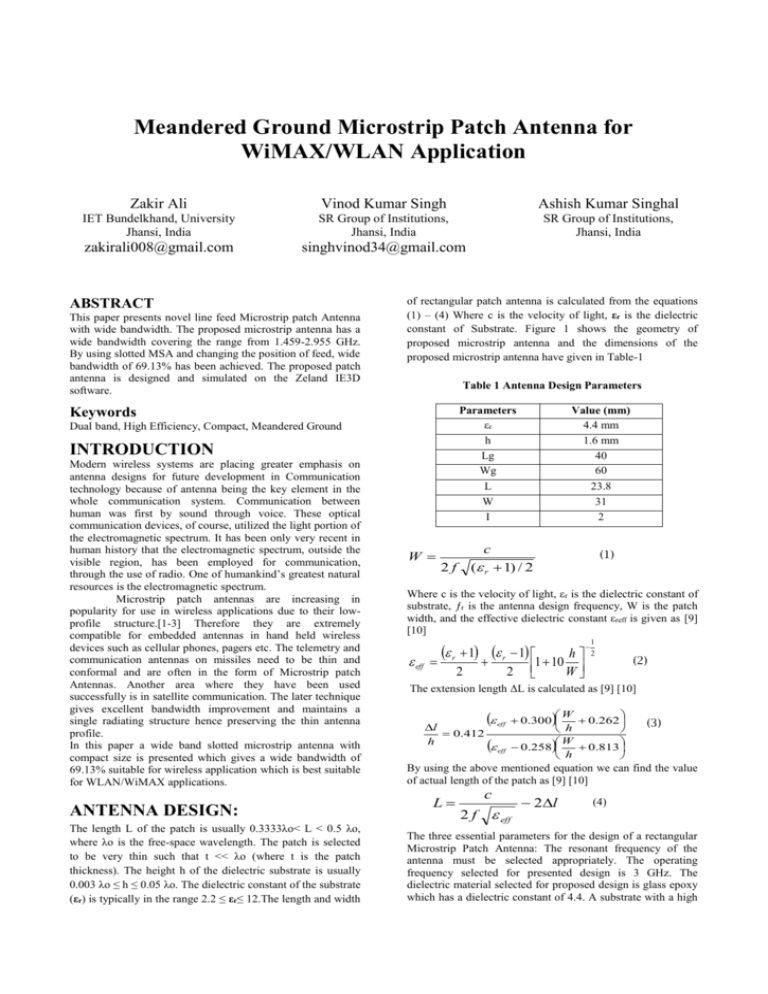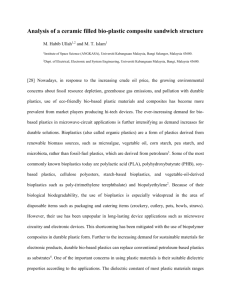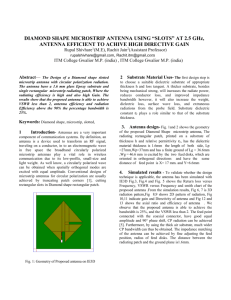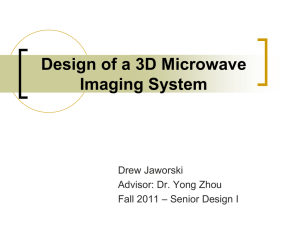introduction - Academic Science
advertisement

Meandered Ground Microstrip Patch Antenna for WiMAX/WLAN Application Zakir Ali Vinod Kumar Singh Ashish Kumar Singhal IET Bundelkhand, University Jhansi, India SR Group of Institutions, Jhansi, India SR Group of Institutions, Jhansi, India zakirali008@gmail.com singhvinod34@gmail.com ABSTRACT This paper presents novel line feed Microstrip patch Antenna with wide bandwidth. The proposed microstrip antenna has a wide bandwidth covering the range from 1.459-2.955 GHz. By using slotted MSA and changing the position of feed, wide bandwidth of 69.13% has been achieved. The proposed patch antenna is designed and simulated on the Zeland IE3D software. of rectangular patch antenna is calculated from the equations (1) – (4) Where c is the velocity of light, εr is the dielectric constant of Substrate. Figure 1 shows the geometry of proposed microstrip antenna and the dimensions of the proposed microstrip antenna have given in Table-1 Table 1 Antenna Design Parameters Parameters εr h Lg Wg L W I Keywords Dual band, High Efficiency, Compact, Meandered Ground INTRODUCTION Modern wireless systems are placing greater emphasis on antenna designs for future development in Communication technology because of antenna being the key element in the whole communication system. Communication between human was first by sound through voice. These optical communication devices, of course, utilized the light portion of the electromagnetic spectrum. It has been only very recent in human history that the electromagnetic spectrum, outside the visible region, has been employed for communication, through the use of radio. One of humankind’s greatest natural resources is the electromagnetic spectrum. Microstrip patch antennas are increasing in popularity for use in wireless applications due to their lowprofile structure.[1-3] Therefore they are extremely compatible for embedded antennas in hand held wireless devices such as cellular phones, pagers etc. The telemetry and communication antennas on missiles need to be thin and conformal and are often in the form of Microstrip patch Antennas. Another area where they have been used successfully is in satellite communication. The later technique gives excellent bandwidth improvement and maintains a single radiating structure hence preserving the thin antenna profile. In this paper a wide band slotted microstrip antenna with compact size is presented which gives a wide bandwidth of 69.13% suitable for wireless application which is best suitable for WLAN/WiMAX applications. ANTENNA DESIGN: The length L of the patch is usually 0.3333λo< L < 0.5 λo, where λo is the free-space wavelength. The patch is selected to be very thin such that t << λo (where t is the patch thickness). The height h of the dielectric substrate is usually 0.003 λo ≤ h ≤ 0.05 λo. The dielectric constant of the substrate (εr) is typically in the range 2.2 ≤ εr≤ 12.The length and width W Value (mm) 4.4 mm 1.6 mm 40 60 23.8 31 2 c (1) ( r 1) / 2 2f Where c is the velocity of light, εr is the dielectric constant of substrate, ƒr is the antenna design frequency, W is the patch width, and the effective dielectric constant εreff is given as [9] [10] eff r 1 r 1 2 2 h 1 10 W 1 2 (2) The extension length ΔL is calculated as [9] [10] l 0.412 h eff eff W 0.300 0.262 h W 0.258 0.813 h (3) By using the above mentioned equation we can find the value of actual length of the patch as [9] [10] L c 2f eff 2l (4) The three essential parameters for the design of a rectangular Microstrip Patch Antenna: The resonant frequency of the antenna must be selected appropriately. The operating frequency selected for presented design is 3 GHz. The dielectric material selected for proposed design is glass epoxy which has a dielectric constant of 4.4. A substrate with a high dielectric constant has been selected since it reduces the dimensions of the antenna. For the microstrip patch antenna is to be used in cellular phones, it is essential that the antenna is not bulky. Hence, the height of the dielectric substrate is selected as 1.6 mm[4-7] Fig.3. Smith Chart plot of proposed microstrip antenna Fig.1. Geometry of proposed micro strip antenna RESULTS AND DISCUSSION Figure 2 shows the return loss Vs frequency plot of proposed microstrip antenna. The slotted antenna resonates at 1.6 GHz and 2.50 GHz frequency giving a wide band width of 69.13% which is suitable for WiMAX/WLAN application. Figure 3 shows the smith chart Vs frequency plot shows the input impedance which should be ideally 50Ω used for impedance matching. Figure 4 shows the VSWR curve which is of presented microstrip antenna obtained from IE3D. The value of VSWR should be less than 2 for desirable communication. The proposed microstrip antenna has better gain and good radiation efficiency. Fig 5 shows 3D radiation pattern which is unidirectional Fig.4. VSWR of proposed microstrip antenna Fig.2. Return loss Vs frequency of proposed microstrip antenna Fig.5. Radiation pattern of proposed microstrip antenna CONCLUSION: A wide band slotted line feed microstrip antenna has simulated & designed on substrate of dielectric constant 4.4. The proposed antenna has been designed on glass epoxy substrate to give a wide bandwidth of 69.13% and maximum radiating efficiency of about 90%. The investigation has been suitable for WLAN/WiMAX applications. REFERENCES 1. Girish Kumar and K.P. Ray, Broadband Microstrip antennas, Artech House 2003. 2. Ramesh Garg, P. Bhartia, Inder Bahl, A. Ittipiboon, Microstip Antenna Design Handbook, Artech House, 2000 3. C. A. Balanis, “Antenna Theory, Analysis and Design,” John Wiley & Sons, New York, 1997. 4. Vinod K. Singh, Zakir Ali Ashutosh Kumar Singh “Dual wideband stacked patch antenna for WiMax and WLAN application” IEEE Proc. Computational Intelligence and Communication Network (CICN- 2011), Print ISBN: 978-1-45772033-8 Page(s): 315 – 318. Gwalior, India. 5. Vinod K. Singh, Zakir Ali, Ashutosh Kumar Singh, Shahanaz Ayub “Dual Band Triangular Slotted Stacked Microstrip Antenna for Wireless Applications” Central European Journal of Engineering (ISSN: 1896-1541), Springer, Volume 3, Issue2, pp221-225, June 2013. 6. Y. X. Guo, L. Bian and X. Q. Shi, "Broadband Circularly Polarized Annular-Ring Microstrip Antenna,"IEEE Transactions on Antennas and Propagation, AP-57, 8, pp. 2474-2477, August 2008. 7. Vinod Kumar Singh, Zakir Ali, Shahanaz Ayub, Ashutosh Kumar Singh, “Dual Band Microstrip Antenna Design Using Artificial Neural Networks” International Journal of Advanced Research in Computer Science and Software Engineering (IJARCSSE) pp-74-79 (ISSN: 2277 128X) Volume 3, Issue 1, January 2013. 8. Tong K.F., Wong T.P.: ‘Circularly polarized U-slot antenna’, IEEE Trans. Antennas Propag55, (8), pp. 2382–2385,2007. 9. Vinod K. Singh, Zakir Ali, “Design and Comparison of a Rectangular-Slot-Loaded and C-Slot-Loaded Microstrip Patch Antenna”, IJCSNS International Journal of Computer Science and Network Security, vol.10 No.4, April 2010 10. Zakir Ali, Vinod K. Singh, Ashutosh Kumar Singh, and Shahanaz Ayub “Wide Band Inset Feed Microstrip Patch Antenna for Mobile Communication” Proc.IEEE, Print ISBN: 978-0-7695-4958-3/13, pp- 51 – 54, April-2013, Gwalior, India. 11. Saurabh Jain, Vinod Kumar Singh, Shahanaz Ayub, “Band Width and Gain Optimization of a Wide Band Gap Coupled Patch Antenna”, International Journal of Engineering Sciences & Research Technology (IJESRT) ISSN 2277–9655 pp-649652, March-2013. 12. B. K. Ang and B. K. Chung, “A Wideband E-shaped microstrip patch antenna for 5–6 GHz wireless Communications,” Progress In Electromagnetic Research, PIER75, 397-407, 2007. 13. Mohammad Tariqul Islam, Mohammed Nazbus, Shakib, Norbahiah Misran, Baharudin Yatim, “Analysis of Broadband Microstrip Patch Antenna,” Proc. IEEE,pp758-761,Dec.2008. . .





